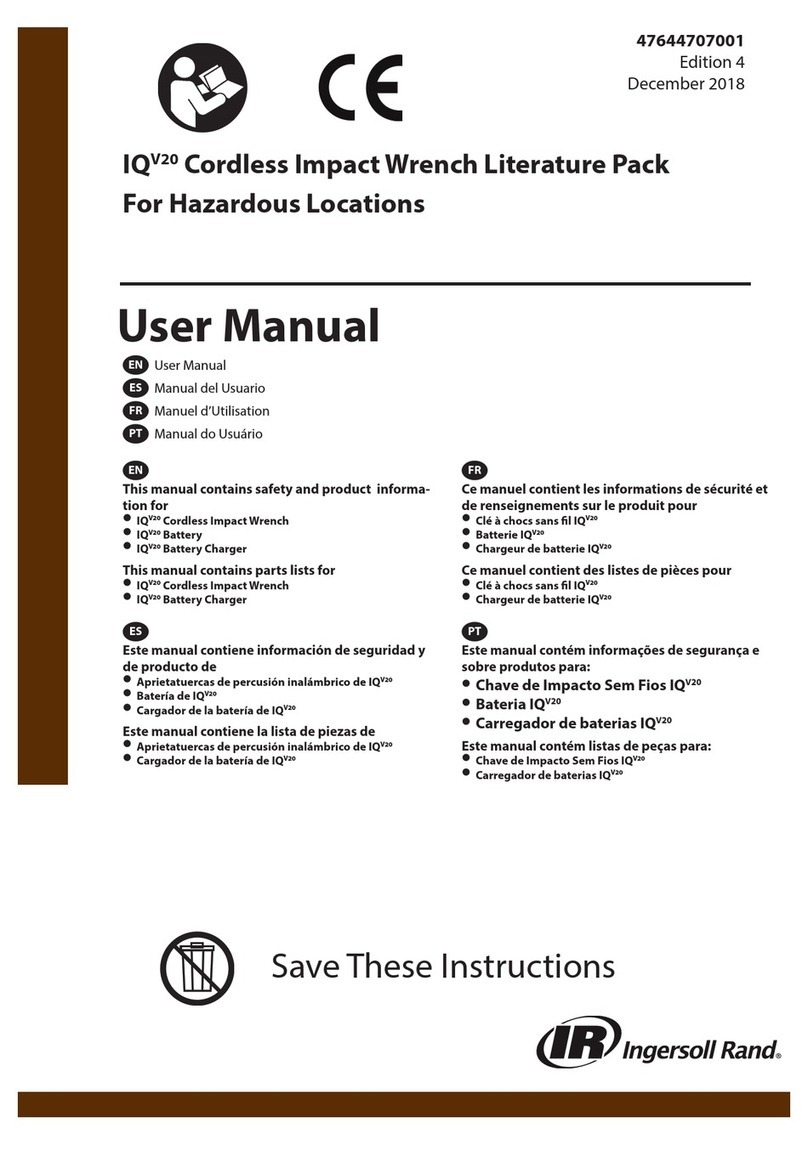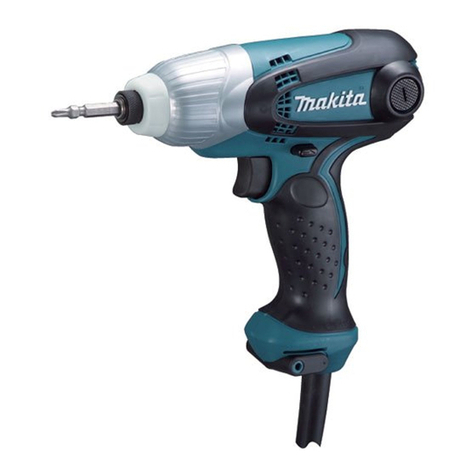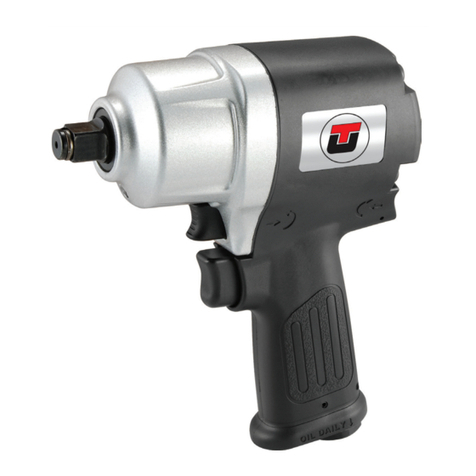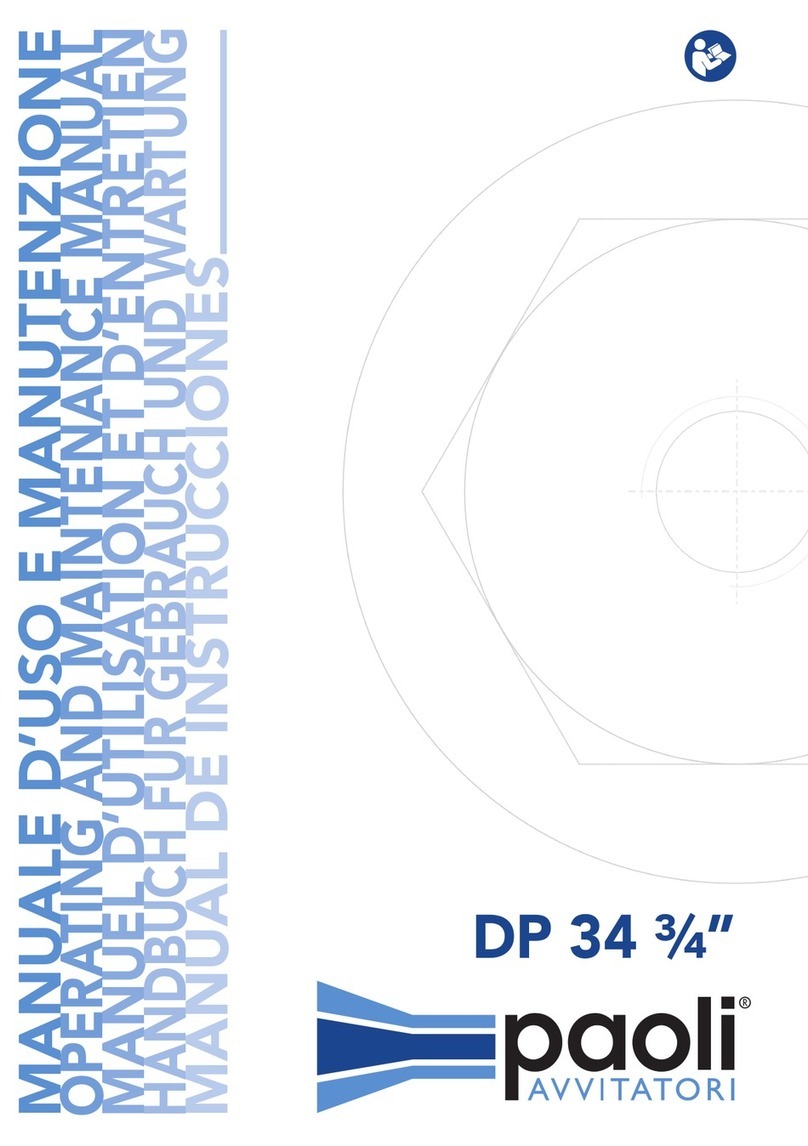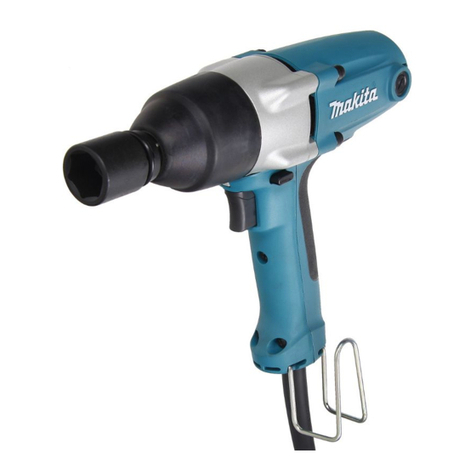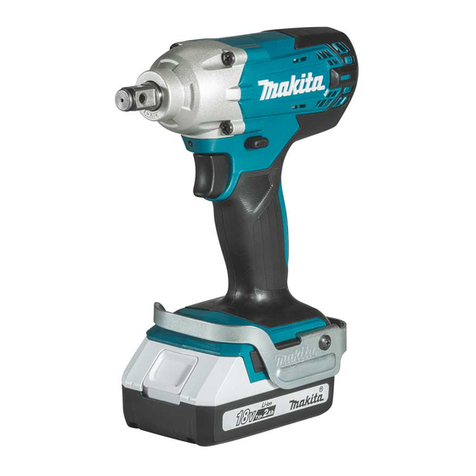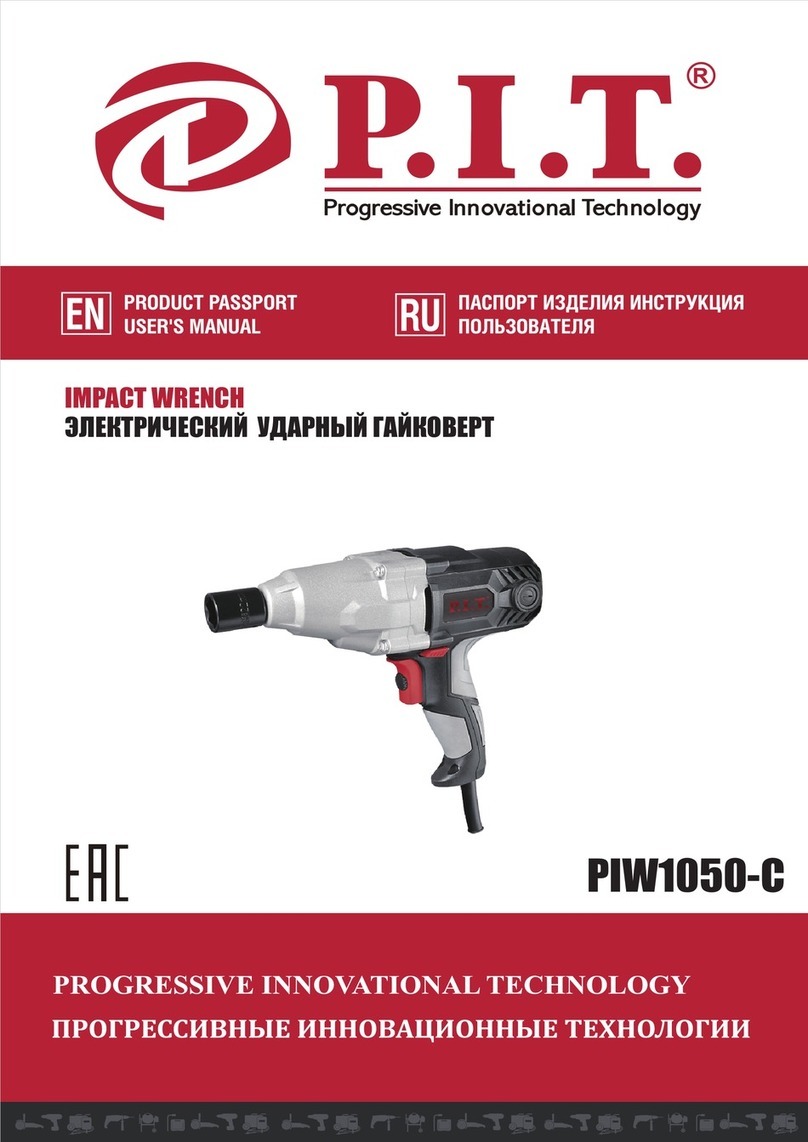Toolshop 241-9897 User manual

3.5A IMPACT WRENCH
241-9897
Owner’s Manual
PRODUCT SPECIFICATIONS
Rating:
120 V AC, 60 Hz
Amperes:
3.5 A
Speed:
0–3200 RPM (no load)
Impact speed:
0–4000 BPM
Torque:
220 ft/lbs
Square drive:
1/2”
Weight:
4 lb 7 oz (2.0 kg)
Need Assistance?
Call us on our toll free customer support line:
1-866-349-8665
Technical questions
Replacement parts
Parts missing from package
Distributed by: Menard, Inc., Eau Claire, WI 54703

2
Product specifications ………….…………………………………………………….
1
Table of contents ……………………………………………………………………...
2
General safety warnings ……………………………………………………………..
3–4
Eye, ear & lung protection ……………………………………………………………
3–4
Electrical safety ……………………………………………………………………….
4
Power tool safety ……………………………………………………………………...
5–6
General safety rules …………………………………………………………………..
5
Work area safety ………………………………………………………………….…..
5
Electrical safety ……………………………………………………………………….
5
Personal safety ………………………………………………………………………..
5–6
Power tool use and care .…………………………………………………………….
6
Service …………………………………………………………………………………
6
Specific safety rules …………………………………………………………………..
7
Extension cord safety ………………………………………………………………...
8
Symbols ………………………………………………………………………………..
9
Know your impact wrench ……………………………………………………………
10
Accessories ……………………………………………………………………………
10
Contents ……………………………………………………………………………….
11
Assembly and operation ……………………………………………………………..
12–17
Installing impact sockets ……………………………………………………………..
12
Installing the hex drive adapter ……………………………………………………...
12–13
Installing a screwdriver bit in the hex adapter ……………………………………..
13
Forward/reverse button ………………………………………………………………
14
Variable speed trigger switch ………………………………………………………..
14
Removing fasteners …………………………………………………………………..
15–16
Driving and removing screws ………………………………………………………..
17
Drilling ………………………………………………………………………………….
17
Maintenance …………………………………………………………………………..
17
Exploded view …………………………………………………………………………
18
Parts list ………………………………………………………………………………..
19–20
Warranty ……………………………………………………………………….………
21
TABLE OF CONTENTS

3
EYE, EAR & LUNG PROTECTION
This instruction manual includes the following:
General Safety Rules
Specific Safety Rules and Symbols
Functional Description
Assembly
Operation
Maintenance
Accessories
!
ALWAYS WEAR EYE PROTECTION THAT CONFORMS WITH CSA
REQUIREMENTS or ANSI SAFETY STANDARD Z87.1
FLYING DEBRIS can cause permanent eye damage. Prescription
eyeglasses ARE NOT a replacement for proper eye protection.
WARNING: Non-compliant eyewear can cause serious injury if
broken during operation of a power tool.
SAVE THESE INSTRUCTIONS FOR REFERENCE
WARNING: Use hearing protection, particularly during extended
periods of operation of the tool or if the operation is noisy.
!
GENERAL SAFETY WARNINGS
CAUTION: Before using this tool or any of its accessories, read this
manual and follow all Safety Rules and Operating Instructions. The
important precautions, safeguards and instructions appearing in this manual
are not meant to cover all possible situations. It must be understood that
common sense and caution are factors which cannot be built into the product.
!

4
ELECTRICAL SAFETY
WARNING: To avoid electrical hazards, fire hazards or damage to the
tool, use proper circuit protection.
This tool is wired at the factory for 120 V operation. It must be connected to
a 120 V 15 A time delayed fuse or circuit breaker. To avoid shock or fire,
replace power cord immediately if it is worn, cut or damaged in any way.
GENERAL SAFETY WARNINGS
WEAR A DUST MASK THAT IS DESIGNED TO BE USED WHEN
OPERATING A POWER TOOL IN A DUSTY ENVIRONMENT.
WARNING: Dust that is created by power sanding, sawing, grinding,
drilling, and other construction activities may contain chemicals that are
known to cause cancer, birth defects. or other genetic abnormalities. These
chemicals include:
Lead from lead-based paints
Crystalline silica from bricks, cement, and other masonry products
Arsenic and chromium from chemically-treated lumber
The level of risk from exposure to these chemicals varies according to how
often this type of work is performed. In order to reduce exposure to these
chemicals, work in a well-ventilated area, and use approved safety
equipment, such as a dust mask that is specifically designed to filter out
microscopic particles.
!

5
WARNING Read all safety warnings
and instructions. Failure to follow the
warnings and instructions may result in
electric shock, fire and/or serious injury.
Save all warnings and instructions for
future reference.
Work area safety
Keep work area clean and well lit.
Cluttered or dark areas invite accidents.
Do not operate power tools in explosive
atmospheres, such as in the presence
of flammable liquids, gases or dust.
Power tools create sparks which may
ignite the dust or fumes.
Keep children and bystanders away
while operating a power tool.
Distractions can cause you to lose control.
Electrical safety
Power tool plugs must match the outlet.
Never modify the plug in any way. Do
not use any adapter plugs with earthed
(grounded) power tools. Unmodified
plugs and matching outlets will reduce risk
of electric shock.
Avoid body contact with earthed or
grounded surfaces such as pipes,
radiators, ranges and refrigerators.
There is an increased risk of electric shock
if your body is earthed or grounded.
Do not expose power tools to rain or
wet conditions. Water entering a power
tool will increase the risk of electric shock.
Do not abuse the cord. Never use the
cord for carrying, pulling or unplugging
the power tool. Keep cord away from
heat, oil, sharp edges or moving parts.
Damaged or entangled cords increase the
risk of electric shock.
When operating a power tool outdoors,
use an extension cord suitable for
outdoor use. Use of a cord suitable for
outdoor use reduces the risk of electric
shock.
If operating a power tool in a damp
location is unavoidable, use a residual
current device (RCD) protected supply.
Use of a ground fault circuit interrupter
(GFCI) reduces the risk of electric shock.
Personal safety
Stay alert, watch what you are doing
and use common sense when operating
a power tool. Do not use a power tool
while you are tired or under the
influence of drugs, alcohol or
medication. A moment of inattention while
operating power tools may result in serious
personal injury.
Use personal protective equipment.
Always wear eye protection. Protective
equipment such as dust mask, non-skid
safety shoes, hard hat, or hearing
protection used for appropriate conditions
will reduce personal injuries.
Prevent unintentional starting. Ensure
the switch is in the off-position before
connecting to power source and/or
battery pack, picking up or carrying the
tool. Carrying power tools with your finger
on the switch or energising power tools
that have the switch on invites accidents.
POWER TOOL SAFETY
!

6
PERSONAL SAFETY –cont’d
Remove any adjusting key or wrench
before turning the power tool on. A
wrench or a key left attached to a rotating
part of the power tool may result in
personal injury.
Do not overreach. Keep proper footing
and balance at all times. This enables
better control of the power tool in
unexpected situations.
Dress properly. Do not wear loose
clothing or jewellery. Keep your hair,
clothing and gloves away from moving
parts. Loose clothes, jewellery or long hair
can be caught in moving parts.
If devices are provided for the
connection of dust extraction and
collection facilities, ensure these are
connected and properly used. Use of
dust collection can reduce dust-related
hazards.
Power tool use and care
Do not force the power tool. Use the
correct power tool for your application.
The correct power tool will do the job
better and safer at the rate for which it was
designed.
Do not use the power tool if the switch
does not turn it on and off. Any power
tool that cannot be controlled with the
switch is dangerous and must be repaired.
Disconnect the plug from the power
source and/or the battery pack from the
power tool before making any
adjustments, changing accessories, or
storing power tools. Such preventive
safety measures reduce the risk of starting
the power tool accidentally.
Store idle power tools out of the reach
of children and do not allow persons
unfamiliar with the power tool or these
instructions to operate the power tool.
Power tools are dangerous in the hands of
untrained users.
Maintain power tools. Check for
misalignment or binding of moving
parts, breakage of parts and any other
condition that may affect the power
tool’s operation. If damaged, have the
power tool repaired before use. Many
accidents are caused by poorly maintained
power tools.
Keep cutting tools sharp and clean.
Properly maintained cutting tools with
sharp cutting edges are less likely to bind
and are easier to control.
Use the power tool, accessories and
tool bits etc. in accordance with these
instructions, taking into account the
working conditions and the work to be
performed. Use of the power tool for
operations different from those intended
could result in a hazardous situation.
Service
Have your power tool serviced by a
qualified repair person using only
identical replacement parts. This will
ensure that the safety of the power tool is
maintained.
POWER TOOL SAFETY

7
WARNING: Know your impact
wrench. Read the Owner’s Manual
carefully. Learn the tool’s applications
and limitations, as well as the specific
potential hazards related to this tool.
Following this rule will reduce the risk of
electric shock, fire or serious injury.
Always wear eye protection.
Any power tool can throw
foreign objects into your eyes
and cause permanent eye
damage. ALWAYS wear safety goggles
(not glasses) that comply with ANSI safety
standard Z87.1. Everyday glasses have
only impact resistant lenses. They ARE
NOT safety glasses.
WARNING: Glasses or goggles
not in compliance with ANSI Z87.1
could cause serious injury when they
break.
Always use hearing protection when
operating the impact wrench.
Hold power tool by insulated gripping
surfaces, when performing an operation
where the fastener may contact hidden
wiring or its own cord. Fasteners
contacting a “live”wire may make exposed
metal parts of the power tool “live”and
could give the operator an electric shock.
Use only impact sockets and accessories
that are designed for use with an impact
wrench. Do not use chrome plated sockets
and accessories. Chrome plated sockets
and accessories are designed for hand
use only and MUST NOT be used with an
impact wrench. They may shatter and
possibly cause serious injury.
Before each use, check the impact sockets
and accessories for excessive wear or
cracks. Worn or damaged sockets or
accessories may shatter and possibly
cause serious injury. Worn accessories
may allow the socket to come off during
operation of the impact wrench.
Never use the impact wrench as a torque
wrench. Always use a torque wrench to
adjust the fastener to the specified torque.
Keep the impact wrench handle and body
clean and free of oil and grease. Always
use a clean dry cloth when cleaning. Do
not use solvents, brake fluid, gasoline or
other petroleum products to clean the tool.
They will damage the tool.
Do not wear neckties or loose clothing.
When wearing gloves, they must be tight
fitting and slip resistant type. Leather
gloves offer the best protection.
Always use two hands when operating the
impact wrench. Use one hand on the
handle and the other on the front of the
tool body.
Never place your hand so it is touching the
socket or accessory when the tool is
turned ON. Your hand could be seriously
injured.
Always remove the plug from the power
source before installing or removing any
socket or accessory.
Be ready for components to shift when
removing any fastener. The speed of the
fastener removal could cause unexpected
shifting of the components.
SPECIFIC SAFETY RULES
!
!

8
WARNING: Keep the extension
cord clear of the work area. Position the
cord so that it will not get caught on the
workpiece, a tool, or any other obstruction
while the power tool is in use.
If an extension cord is used with this
impact wrench, verify that it is in good
condition. When using an extension cord,
be sure to use one that is heavy enough to
carry the current that the tool will draw. An
undersized cord will cause a drop in line
voltage, which will result in a loss of power
and overheating.
The following table shows the correct size
to use according to cord length and the
amperage rating that is listed ton the tool's
nameplate. When in doubt, use the next
heavier gauge. The smaller the gauge
number, the heavier the cord.
Verify that the extension cord is properly
wired and in good condition. Replace a
damaged extension cord immediately, or
have it repaired by a qualified electrician
before using it. Keep the extension cord
away from sharp objects, excessive heat,
and damp or wet areas.
Use a separate electrical circuit for power
tools. This circuit must consist of not less
than 14 gauge wire, and should be
protected by either a 15 A time-delayed
fuse or a circuit breaker. Before connecting
the power tool to the outlet, verify that the
switch is in the OFF position, and that the
voltage of the power source is the same as
the voltage that is indicated on the tool's
nameplate. Running this impact wrench at
lower voltage will damage the motor.
EXTENSION CORD SAFETY
!
MINIMUM GAUGE (AWG)
EXTENSION CORDS (120 V use only)
Amperage
rating
Total length
More
than
Not
more
than
25'
(7.5 m)
50'
(15 m)
100'
(30 m)
150'
(45 m)
0
6
18
16
16
14
6
10
18
16
14
12
10
12
16
16
14
12
12
16
14
12
Not Applicable

9
V
Volts
A
Amperes
Hz
Hertz
W
Watts
kW
Kilowatts
Microfarads
L
Litres
kg
Kilograms
H
Hours
N/cm2
Newtons per square
centimeter
Pa
Pascals
Min
Minutes
S
Seconds
Alternating current
Three-phase alternating
current
Three-phase alternating
current with neutral
Direct current
No load speed
Alternating or direct
current
Class II construction
Splash-proof
construction
Watertight construction
Protective grounding at
grounding terminal,
Class I tools
Revolutions or
reciprocations per
minute
Diameter
Off position
Arrow
Warning symbol
SYMBOLS
WARNING: Some of the following symbols may appear on the impact
wrench. Study these symbols and learn their meaning. Proper interpretation
of these symbols will allow for more efficient and safer operation of this tool.
!
This symbol designates that
this tool is listed with both
Canadian and U.S.
requirements by Underwriters
Laboratories.
61TN
E213739
JD2171U

10
AVAILABLE ACCESSORIES
WARNING: Use only accessories
that are recommended for this impact
wrench. Follow the instructions that
accompany the accessories. The use of
improper accessories may result in
injury to the operator or damage to the
impact wrench.
Before using any accessory, carefully read
the instructions or the owner’s manual for
the accessory.
Impact sockets
Impact extensions
Impact adapters
Impact nut drivers
Impact screwdriver bits
WARNING: If any part is missing or
damaged, do not plug the impact wrench
into the power source until the missing or
damaged part is replaced.
KNOW YOUR IMPACT WRENCH
ACCESSORIES
!
!
½” square
drive
Air vents
Variable speed
trigger switch
Air vents
Handle
Forward/reverse
button

11
CONTENTS
Carefully unpack the impact wrench.
Compare against the “COMPONENTS”
chart below.
NOTE: See illustration of impact wrench at
right.
WARNING: To avoid fire or toxic
reaction, never use gasoline, naphtha,
acetone, lacquer thinner or similar
highly volatile solvents to clean the
tool.
!
CONTENTS
IMPACT WRENCH KIT
COMPONENTS
KEY
DESCRIPTION
QTY
A
Impact wrench
1
1/2" drive impact
sockets:
1/2", 5/8", 3/4", 7/8", 1"
5
1/2" to 1/4" hex
drive quick release
adapter
1
1/4" hex drive
nut drivers:
3/16", 1/4", 9/32",
5/16", 11/32", 3/8",
7/16"
7
Screwdriver bits:
●#1, #2, #3
3
Screwdriver bits:
●#1, #2, #3
3
Blow molded case
(Not illustrated)
1
Owner’s manual
1

12
INSTALLING IMPACT SOCKETS
WARNING: Use only impact
sockets and accessories that are
designed for use with an impact
wrench. Do not use chrome plated
sockets and accessories. Chrome plated
sockets and accessories are designed for
hand use only and MUST NOT be used
with an impact wrench. They may shatter
and possibly cause serious injury.
WARNING: Always remove the plug
from the power source before changing
any sockets or accessories. You may
injure your hand if the tool is started
accidentally.
To install a socket, press the square
portion of the socket (1) onto the square
drive (2) of the impact wrench (Fig. 1).
NOTE: Slide the socket fully onto the
square drive so the socket retainer (3) will
hold the socket firmly in place
INSTALLING THE HEX DRIVE ADAPTER
By installing the 1/2" square to 1/4" hex
adapter, the impact wrench can be used
as an impact driver for driving screws and
for use with impact nut drivers.
1. Pull outward on the large quick
connect collar (1) (Fig. 2).
2. Slide the adapter over the impact
wrench 1/2" drive (2).
3. When the adapter is fully on the 1/2"
drive, release the collar.
ASSEMBLY AND OPERATION
!
!
Fig. 1
Fig. 2

13
INSTALLING THE HEX DRIVE ADAPTER –
cont’d
4. When the collar is released, pull
outward on the hex drive sleeve (3) to
ensure the retaining balls inside the
1/2" drive collar are engaged with the
1/2" drive of the impact wrench.
INSTALLING A SCREWDRIVER BIT IN
THE HEX ADAPTER
1. To install a screwdriver bit, pull
outward on the small hex drive sleeve
(1) (Fig. 3). While holding the hex
drive sleeve out, insert the bit (2) fully
into the hex drive and then release the
outer sleeve.
2. When the hex drive sleeve is
released, pull outward on the bit to
ensure the retaining balls inside the
hex drive are engaged with the groove
in the bit (3) to prevent the bit from
sliding out of the hex drive.
NOTE: Pulling outward on the bit will also
ensure the adapter is fully locked onto the
impact wrench 1/2" drive.
3. To remove the bit, pull outward on the
hex drive sleeve and pull the bit out of
the hex drive.
WARNING: Never use a screwdriver
bit, nut driver or any other 1/4" hex drive
accessory that does NOT have the locking
groove. These accessories will not be
adequately held in the hex drive and could
come loose and possibly injure the
operator.
ASSEMBLY AND OPERATION
!
Fig. 2
Fig. 3

14
FORWARD/REVERSE BUTTON
This impact wrench is equipped with a
forward/reverse button (1) (Fig. 4).
1. To operate the impact wrench in the
reverse direction, press the
forward/reverse button to the RIGHT.
This direction of rotation will loosen
the fastener.
2. To operate the impact wrench in the
forward direction, press the
forward/reverse button to the LEFT.
This direction of rotation will tighten
the fastener.
NOTE: Never press the forward/reverse
button while the tool it turned ON. Damage
to the tool will result.
VARIABLE SPEED TRIGGER SWITCH
This impact wrench is equipped with a
variable-speed ON/OFF trigger switch.
1. To start impact wrench, gently
squeeze the trigger switch (2) (Fig. 5).
NOTE: The impact wrench will turn at its
slowest speed when the trigger switch is
depressed slightly. The impact wrench will
turn at its fastest speed when the trigger
switch is fully depressed.
2. To stop the impact wrench, release
the trigger switch.
NOTE: If the tool gets warm while running
at slow speeds, stop and allow it to cool.
ASSEMBLY AND OPERATION
Fig. 5
Fig. 4

15
REMOVING FASTENERS
One of the most common uses for the
impact wrench is to remove car wheel nuts
for rotating the tires. Car wheel nut
removal is used for illustrative purposes.
DANGER: Before attempting to
remove a car wheel, make sure all
jacking, wheel blocking and wheel
removal safety procedures illustrated in
the Owner’s Manual for your car are
followed exactly. Failure to follow those
safety instructions could result in
serious injury or death.
ASSEMBLY AND OPERATION
!
For safety reasons, the operator
must read the sections of this
Owner’s Manual entitled “GENERAL
SAFETY WARNINGS”, “POWER
TOOL SAFETY”, “SPECIFIC SAFETY
RULES”, “EXTENSION CORD
SAFETY” and “SYMBOLS” before
using this impact wrench.
Verify the following every time the
impact wrench is used:
1. Safety glasses and hearing
protection are being worn.
2. Socket or accessory is “impact
wrench” rated.
3. Socket or accessory is in good
condition.
Failure to observe these safety rules
will significantly increase the risk of
injury.
WARNING
!

16
REMOVING FASTENERS –cont’d
1. Install the correct size of impact
socket on the impact wrench as
outlined in Fig. 1
2. Set the forward/reverse button to the
RIGHT for removing fasteners (Fig. 4).
3. Plug the impact wrench power cord
into an appropriate power source.
4. Grasp the impact wrench handle (1)
with one hand and the front housing of
the impact wrench (2) with the other
hand (Fig. 6).
5. Place impact socket (3) onto the
wheel nut.
NOTE: Make sure the socket is fully
engaged with the nut to avoid potentially
damaging the socket or the wheel nut.
6. While holding the tool level with the
ground and with a firm grasp, squeeze
the trigger switch (4).
When removing fasteners, do not operate
the impact wrench for more than 15
seconds unless the fastener begins to turn.
If the fastener fails to turn within 15
seconds, reverse the direction of rotation
and operate the impact wrench in a
forward direction on the fastener for a few
seconds. Now switch back to reverse
direction and remove the fastener. This
procedure will usually break loose seized
or “frozen” fasteners.
WARNING: Operating the impact
wrench for more that 15 seconds at a time
on a seized or “frozen” fastener will place
severe stress on the impact wrench and
cause damage. It may also break the
fastener.
!
Fig. 4
!
ASSEMBLY AND OPERATION
Fig. 6

17
DRIVING AND REMOVING SCREWS
When driving or removing screws, always
use the largest screwdriver bit that will
properly fit into the head of the screw to
prevent damage to the screwdriver bit and
the screw head. When starting the tool,
make sure you are pressing the bit straight
and firmly into the screw head. To avoid
over driving screws or damaging the screw
head or the screwdriver bit, start the tool at
a slow speed and DO NOT allow it to
continue to run in the impact mode for
more than a few seconds.
DRILLING
Drill bits with a 1/4" hex shank can be used
in the 1/2" square to 1/4" hex adapter.
Whenever possible, use a center punch to
mark the location of the hole to be drilled.
When starting the tool, make sure the drill
bit is lightly touching the workpiece where
the hole is to be drilled. This will ensure
the drill starts in the correct location
without “wandering” as you start drilling.
GENERAL
WARNING: When servicing, use
only identical replacement parts. Use of
any other part may create a hazard or
cause product damage.
DO NOT use solvents when cleaning
plastic parts. Plastics are susceptible to
damage from various types of commercial
solvents and may be damaged by their
use. Use a clean cloth to remove dirt, dust,
oil, grease etc.
WARNING: Do not at any time
allow brake fluids, gasoline, petroleum-
based products, penetrating oils, etc. to
come into contact with plastic parts.
They contain chemicals that can
damage, weaken or destroy plastic.
DO NOT abuse power tools. Abusive
practices can damage the tool as well as
the workpiece.
WARNING: DO NOT attempt to
modify tools or create accessories. Any
such alteration or modification is
misuse and could result in a hazardous
condition leading to possible serious
injury. It will also void the warranty.
LUBRICATION
All of the bearings in this tool are
lubricated with a sufficient amount of high-
grade lubricant for the life of the unit under
normal conditions. Therefore, no further
lubrication is required.
!
!
!
MAINTENANCE
ASSEMBLY AND
OPERATION

18
EXPLODED VIEW
3
4
5
8
9
10
12
14
15
16
21
22
23
24
25
1
2
6
7
11
13
17
19
20
26
27
28
29
30
32
33
34
35
36
37
40
41
38
39
18
31

19
WARNING: When servicing, use only original equipment replacement parts. The
use of any other parts may create a safety hazard or cause damage to the impact wrench.
Any attempt to repair or replace electrical parts on this impact wrench may create a safety
hazard unless repairs are performed by a qualified technician. For more information, call
the Toll-Free Helpline, at 1-866-349-8665.
Always order by PART NUMBER, not by key number.
Key #
Part #
Part Name
Quantity
1
6591391913
Self tapping screw ST3.9×19
4
2
6609040003
Spring washer
4
3
5200390101
Aluminium armature
1
4
5100350101
Shaft coat
1
5
4600260101
Washer
1
6
5400680101
Washer
1
7
6300550101
Shaft
1
8
6910550101
BallΦ5.5
2
9
6100160101
Torque
1
10
6910400101
BallΦ4
24
11
5400580101
Washer
1
12
5500240101
Spring
1
13
5400580101
Washer
1
14
6300110101
Shaft
1
15
5100340101
Gear
2
16
6902061509
Pin Φ6×15.5
2
17
5400250101
Washer
1
18
6801150121
Bearing 6002RS
1
19
5100310101
Inner gear ring
1
20
4401000101
Gear box
1
PARTS LIST
!

20
Key #
Part #
Part Name
Quantity
21
6801100121
Bearing 6000RS
1
22
3700130101
Rotor assembly
1
23
6801070321
Bearing 607RS
1
24
3800130101
Stator
1
25
4400980101
Brush holder
1
26
5612090101
Brush holder support
2
27
5615110101
Brush holder
2
28
5611110101
Carbon brush
2
29
5624010101
Carbon brush cap
2
30
4408680101
Decorative plate
1
31
5101850101
Magnet Block
1
32
4300170101
Left enclosure
1
33
4401050101
Direction setting button
1
34
3300030301
Switch assembly
1
35
6910350101
Right enclosure
1
36
6411391913
Self tapping screw ST3.9×19
5
37
6411391413
Self tapping screw ST3.9×14
4
38
5400070101
Cord clamp
1
39
6411391413
Self tapping screw ST3.9×14
2
40
4600020101
Cord guard
1
41
7266050334
Cord
1
PARTS LIST
Table of contents
Other Toolshop Impact Driver manuals
Popular Impact Driver manuals by other brands
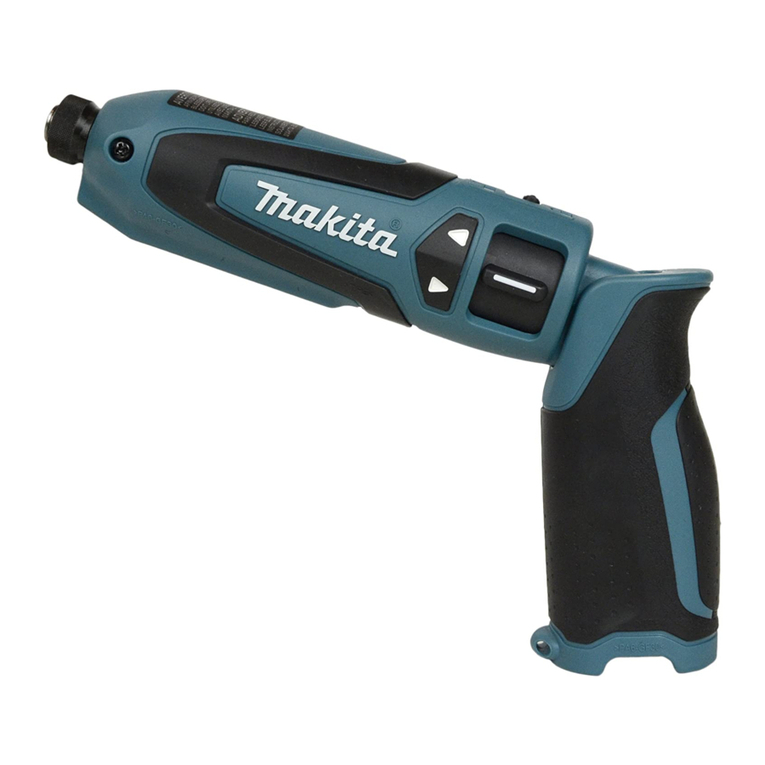
Makita
Makita TD021D instruction manual

Ingersoll-Rand
Ingersoll-Rand 2131 Series instructions
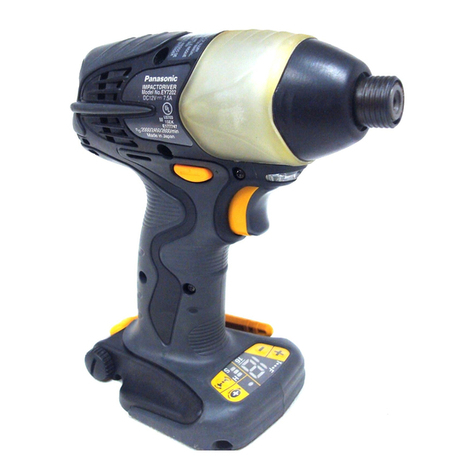
Panasonic
Panasonic EY7202 - 12V IMPACT DRIVER operating instructions

Wolpertech
Wolpertech 04011 Translation of the original instructions

Narex
Narex ESR 500 Original operating manual

RIDGID
RIDGID PSBIW01 Operator's manual


